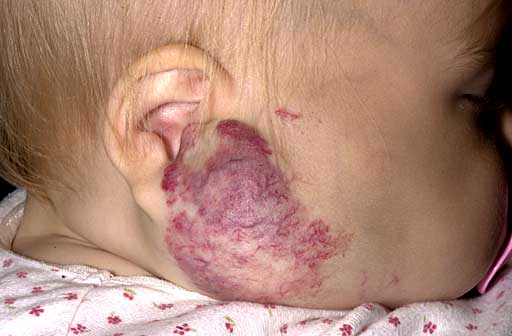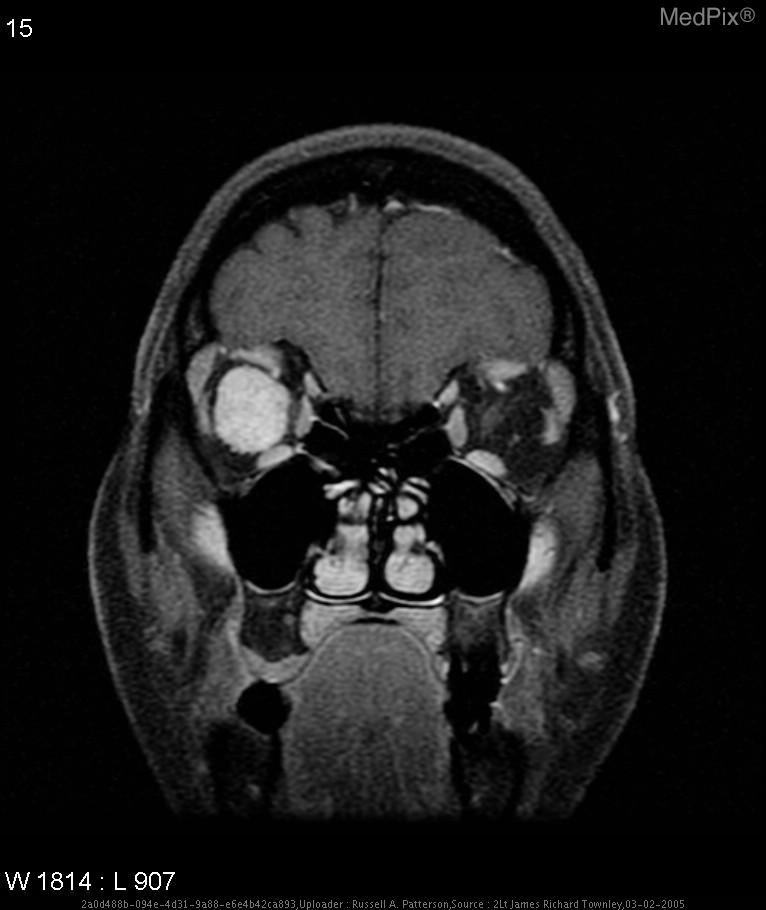Cavernous angioma physical examination
|
Cavernous angioma Microchapters |
|
Diagnosis |
|---|
|
Treatment |
|
Case Studies |
|
Cavernous angioma physical examination On the Web |
|
American Roentgen Ray Society Images of Cavernous angioma physical examination |
|
Risk calculators and risk factors for Cavernous angioma physical examination |
Editor-In-Chief: C. Michael Gibson, M.S., M.D. [1]; Associate Editor(s)-in-Chief: Edzel Lorraine Co, D.M.D., M.D.
Overview
Cavernous angioma, also known as cavernous hemangioma, can affect several organs. Diagnosing this condition should be correlated with imaging findings.
Physical Examination
Cavernous angioma, also known as cavernous hemangioma, can affect several organs. Diagnosing this condition should be correlated with imaging findings.
General Appearance
Patient usually appears normal and not in distress.
Skin
Skin examination findings may reveal an erythematous blebs to tumor-like growths which usually appear from birth up to 18 months.

HEENT
 |
- Eyes: Cavernous hemangioma could cause exophthalmia of the eyes. [2]
- Ears: Physical findings can be normal.
- Nose: It can cause obstruction of nasal airways and might lead up to epistaxis. [3]
- Neck: A well-circumscribed mass affecting the thyroid glands can be seen in the neck.
Respiratory System
- Cavernous hemangioma can appear as multiple small nodules mimicking some lung masses.[4]
Cardiovascular System
- A mass can be seen on the mediastinum, or in the atrium.[5]
Gastrointestinal System
- It can also affect the esophagus showing as a well-circumscribed mass. [6][7]
- Intra-tumoral hemorrhage can be seen in a person with cavernous angioma.[8]
Endocrine System
- Adrenals: Adrenals can show as an abdominal mass.[9]
Genitourinary System
- Cavernous hemangioma affecting the genitourinary system can present as abdominal pain with hemoglobinuria. [10]
Musculoskeletal System
- Patients usually has no pertinent findings.
Nervous System
- Patients usually has no pertinent findings.
References
- ↑ http://picasaweb.google.com/mcmumbi/USMLEIIImages/photo#5089143114176965938
- ↑ Bachelet JT, Berhouma M, Shipkov H, Kodjikian L, Jouanneau E, Gleizal A (2018). "Orbital Cavernous Hemangioma Causing Spontaneous Compressive Hemorrhage". J Craniofac Surg. 29 (3): 706–708. doi:10.1097/SCS.0000000000004285. PMID 29419596.
- ↑ Baki A (2018). "Nasal Septal Cavernous Hemangioma". J Craniofac Surg. 29 (2): e135–e136. doi:10.1097/SCS.0000000000004220. PMID 29215446.
- ↑ Lee JH, Lee YU, Kang HJ (2021). "Multiple Cavernous Hemangiomas of the Posterior Mediastinum, Lung, and Liver: A Case Report". J Chest Surg. 54 (6): 547–550. doi:10.5090/jcs.21.093. PMC 8646077 Check
|pmc=value (help). PMID 34857673 Check|pmid=value (help). - ↑ Xu J, Piao H, Wang D, Wang Y, Li B, Wang T; et al. (2019). "Large left atrial cavernous hemangioma, a case report". J Cardiothorac Surg. 14 (1): 199. doi:10.1186/s13019-019-1005-9. PMC 6858712 Check
|pmc=value (help). PMID 31730003. - ↑ Shen XC, Zhou YB, Zhu YJ, Chen DF, Lan CH (2021). "A Large Cavernous Hemangioma of Esophagus". Am J Gastroenterol. 116 (2): 236. doi:10.14309/ajg.0000000000000699. PMID 32467504 Check
|pmid=value (help). - ↑ Miao J, Chen S, Li Y, Fu L, Li H (2017). "A primary cavernous hemangioma of the thyroid gland: A case report and literature review". Medicine (Baltimore). 96 (49): e8651. doi:10.1097/MD.0000000000008651. PMC 5728839. PMID 29245224.
- ↑ Dima-Cozma LC, Bitere OR, Pantazescu AN, Gologan E, Mitu F, Rădulescu D; et al. (2018). "Cavernous liver hemangioma complicated with spontaneous intratumoral hemorrhage: a case report and literature review". Rom J Morphol Embryol. 59 (2): 557–561. PMID 30173262.
- ↑ Feo CV, De Troia A, Pedriali M, Sala S, Zatelli MC, Carcoforo P; et al. (2018). "Adrenal cavernous hemangioma: a case report". BMC Surg. 18 (1): 103. doi:10.1186/s12893-018-0429-9. PMC 6247755. PMID 30458815.
- ↑ Momeni M, Momeni F (2019). "Ruptured inferior vena cava aneurysm in the setting of mural vascular malformation: A case report". J Clin Ultrasound. 47 (7): 423–425. doi:10.1002/jcu.22708. PMID 30801724.